CHEVROLET CAMARO 1994 4.G Repair Manual
Manufacturer: CHEVROLET, Model Year: 1994, Model line: CAMARO, Model: CHEVROLET CAMARO 1994 4.GPages: 292, PDF Size: 15.35 MB
Page 61 of 292
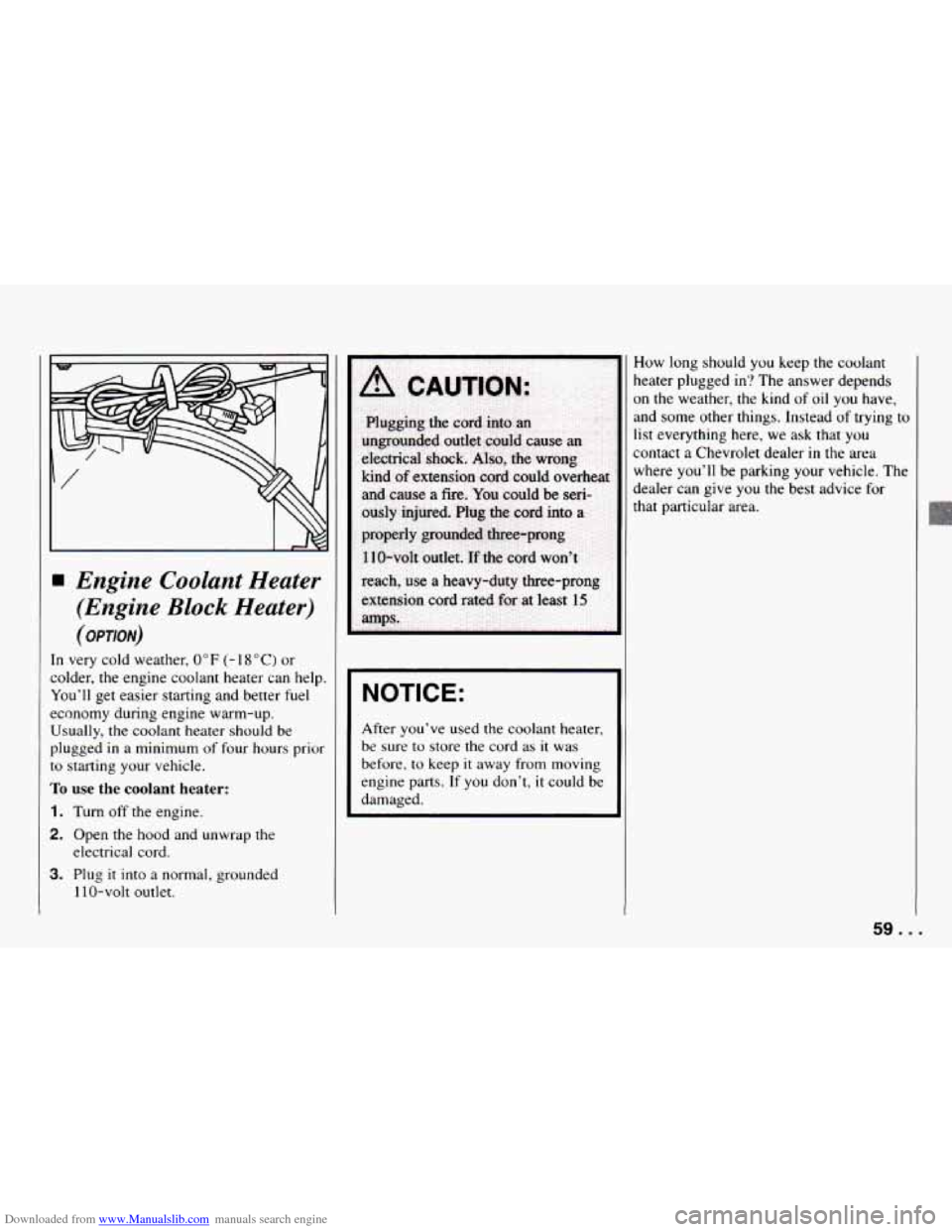
Downloaded from www.Manualslib.com manuals search engine Engine Coolant Heater
(Engine Block Heater)
(OPTION)
In very cold weather, 0°F (- 1 8 "Cj or
colder, the engine coolant heater can help.
You'll get easier starting and better fuel
economy during engine warm-up.
Usually, the coolant heater should be
plugged
in a minimum of four hours prior
to starting your vehicle.
To use the coolant heater:
1. Turn off the engine.
2. Open the hood and unwrap the
electrical cord.
3. Plug it into a normal, grounded
110-volt outlet.
NOTICE:
After you've used the coolant heater,
be sure
to store the cord as it was
before, to keep
it away from moving
engine parts.
If you don't, it could be
damaged.
How long should you keep the coolant
heater plugged in? The answer depends
on the weather, the kind
of oil you have,
and some other things. Instead
of trying to
list everything here, we ask that
you
contact a Chevrolet dealer in the area
where you'll be parking your vehicle. The
dealer can give
you the best advice for
that particular area.
59. .
Page 62 of 292
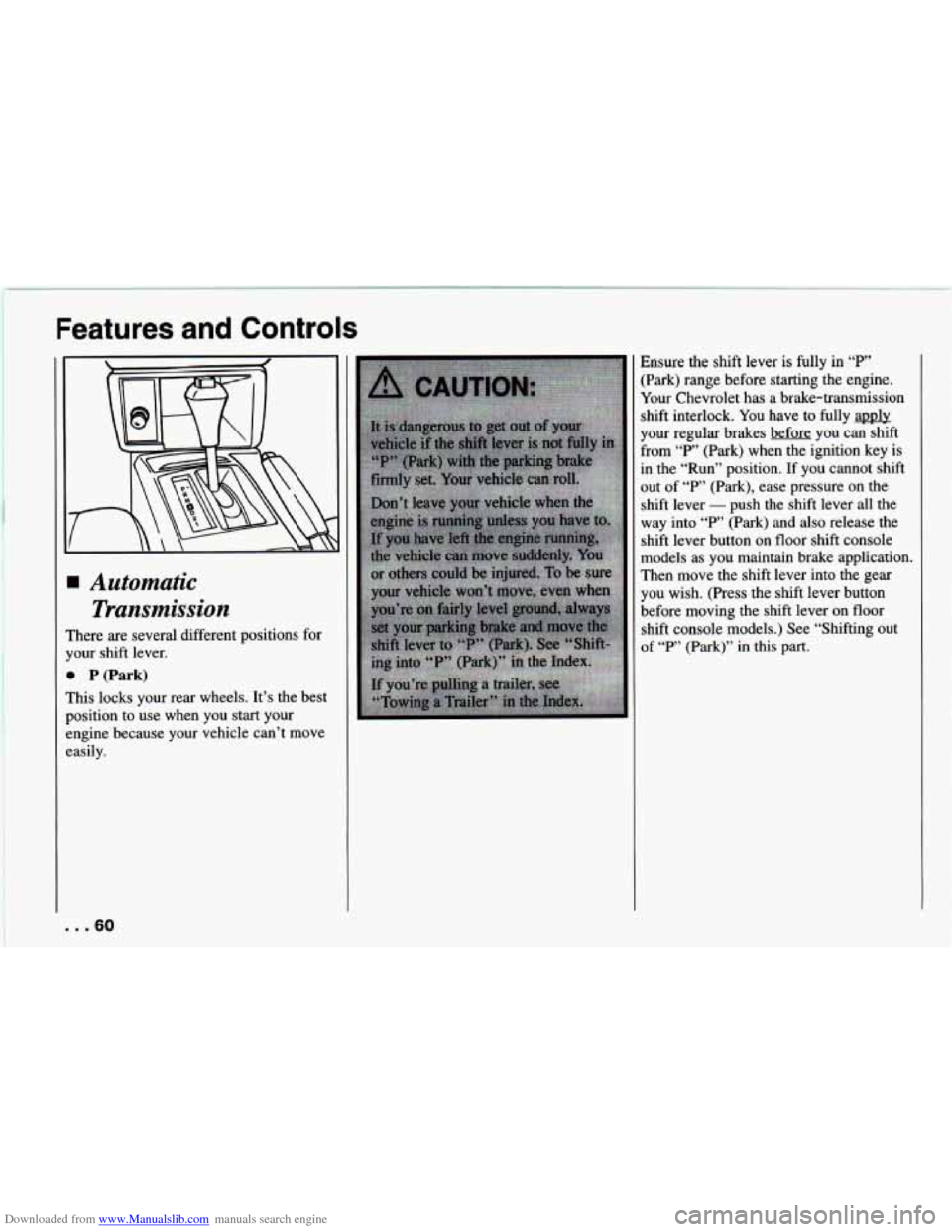
Downloaded from www.Manualslib.com manuals search engine Features and Controls
Automatic Transmission
rhere are several different positions for
Tour shift lever.
B P (Park)
rhis locks your rear wheels. It’s the best
losition to use when you start your
:ngine because your vehicle can’t move
:asily. Ensure the shift
lever
is fully in “P’
:Park) range before starting the engine.
Your Chevrolet has a brake-transmission
shift interlock.
You have to fully apuly
your regular brakes before
you can shift
From
“P’ (Park) when the ignition key is
In the “Run” position. If you cannot shift
]ut of
“P’ (Park), ease pressure on the
shift lever
- push the shift lever all the
way into
“P’ (Park) and also release the
shift lever button on floor shift console
models as you maintain brake application.
I‘hen move the shift lever into the gear
you wish. (Press the shift lever button
before moving the shift lever on floor
shift console models.) See “Shifting out
Df “P’ (Park)” in this part.
. ..60
Page 63 of 292
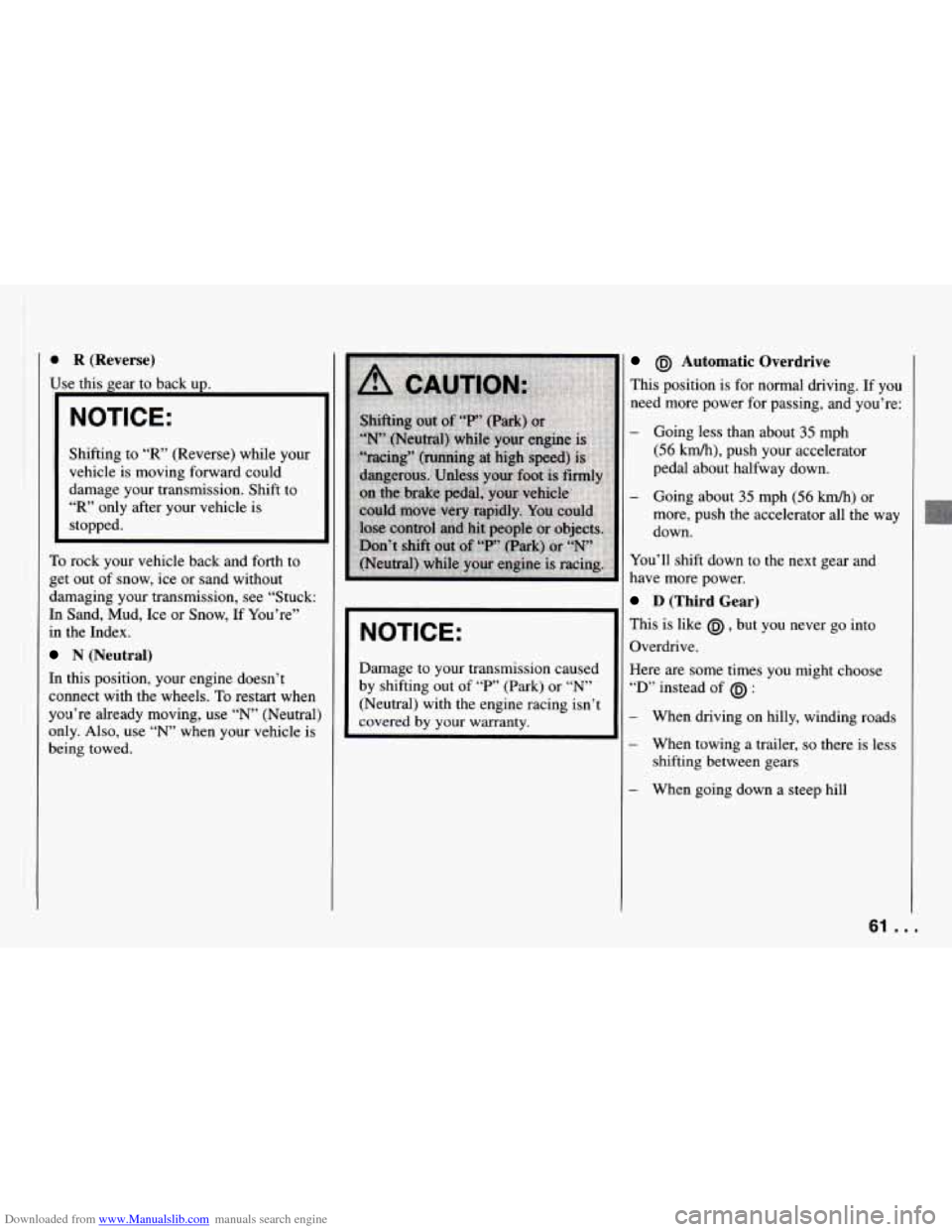
Downloaded from www.Manualslib.com manuals search engine i
0 R (Reverse)
$e this gear to back up.
NOTICE:
Shifting to “R’ (Reverse) while your
vehicle is moving forward could
damage your transmission. Shift to
“R’ only after your vehicle is
stopped.
To rock your vehicle back and forth to
get out of snow, ice or sand without
damaging your transmission, see “Stuck:
In Sand, Mud, Ice or Snow, If You’re’’
in the Index.
N (Neutral)
In this position, your engine doesn’t
connect with the wheels.
To restart when
you’re already moving, use
“N” (Neutral)
only. Also,
use “N” when your vehicle is
being towed.
NOTICE:
Damage to your transmission caused
by shifting out of
“P’ (Park) or “N’
(Neutral) with the engine racing isn’t
covered by your warranty.
@J Automatic Overdrive
This position is for normal driving. If you
need more power for passing,
and you’re:
- Going less than about 35 mph
(56 km/h), push your accelerator
pedal about halfway down.
- Going about 35 mph (56 km/h) or
more, push the accelerator all the way
down.
You’ll shift down to the next gear and
have more power.
D (Third Gear)
This is like @ , but you never go into
Overdrive.
Here are some times
you might choose
“D’ instead of @J :
When driving on hilly, winding roads
When towing a trailer,
so there is less
shifting between gears
When going down a steep hill
61 ...
Page 64 of 292
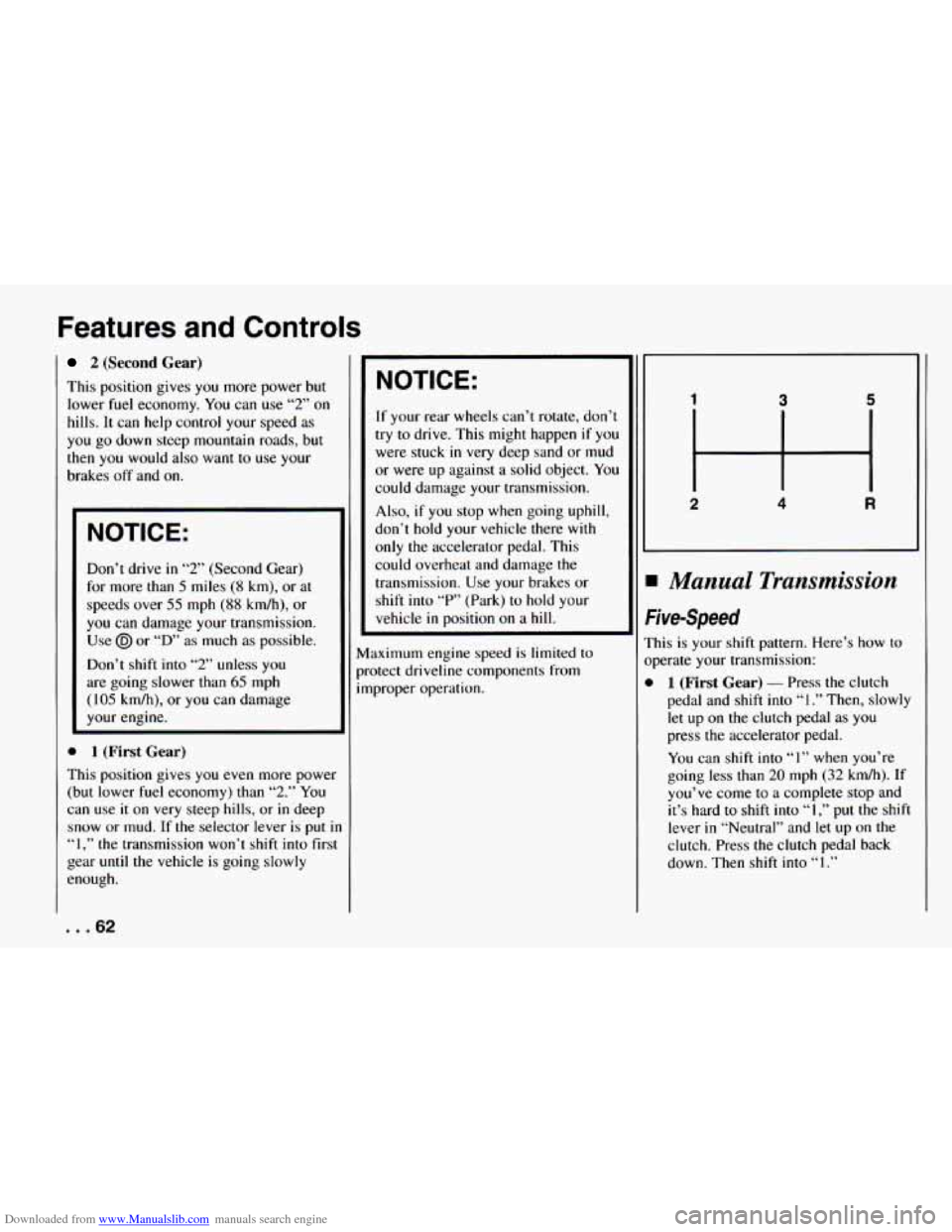
Downloaded from www.Manualslib.com manuals search engine Features and Controls
2 (Second Gear)
This position gives you more power but
lower fuel economy. You can use
“2” on
hills.
It can help control your speed as
you go down steep mountain roads, but
then you would also want to
use your
brakes off and on.
NOTICE:
Don’t drive in “2” (Second Gear)
for more than
5 miles (8 km), or at
speeds over
55 mph (88 km/h), or
you can damage your transmission.
Use
@I or “D’ as much as possible.
Don’t shift into
“2” unless you
are going slower than
65 mph
( 105 km/h), or you can damage
your engine.
0 1 (First Gear)
This position gives you even more power
(but lower fuel economy) than “2.” You
can use
it on very steep hills, or in deep
snow or mud.
If the selector lever is put i~
“1,” the transmission won’t shift into firsf
gear
until the vehicle is going slowly
enough.
NOTICE:
If your rear wheels can’t rotate, don’t
try to drive. This might happen
if you
were stuck
in very deep sand or mud
or were up against a solid object. You
could damage your transmission.
Also, if you stop when going uphill,
don’t hold your vehicle there with
only the accelerator pedal. This
could overheat and damage the
transmission. Use your brakes or
shift
into “P” (Park) to hold your
vehicle
in position on a hill.
Maximum engine speed
is limited to
protect driveline components from
improper operation.
1 3 5
2 4 R
I Manual Transmission
%e-Speed
:his is your shift pattern. Here’s how to
tperate your transmission:
1 (First Gear) - Press the clutch
pedal and
shift into “I.” Then, slowly
let
up on the clutch pedal as you
press the accelerator pedal.
You can shift into “1” when you’re
going less
than 20 mph (32 kdh). If
you’ve come to a complete stop and
it’s hard to shift into
“1,” put the shift
lever
in “Neutral” and let up on the
clutch. Press the clutch pedal back
down. Then shift into
“1.”
... 62
Page 65 of 292
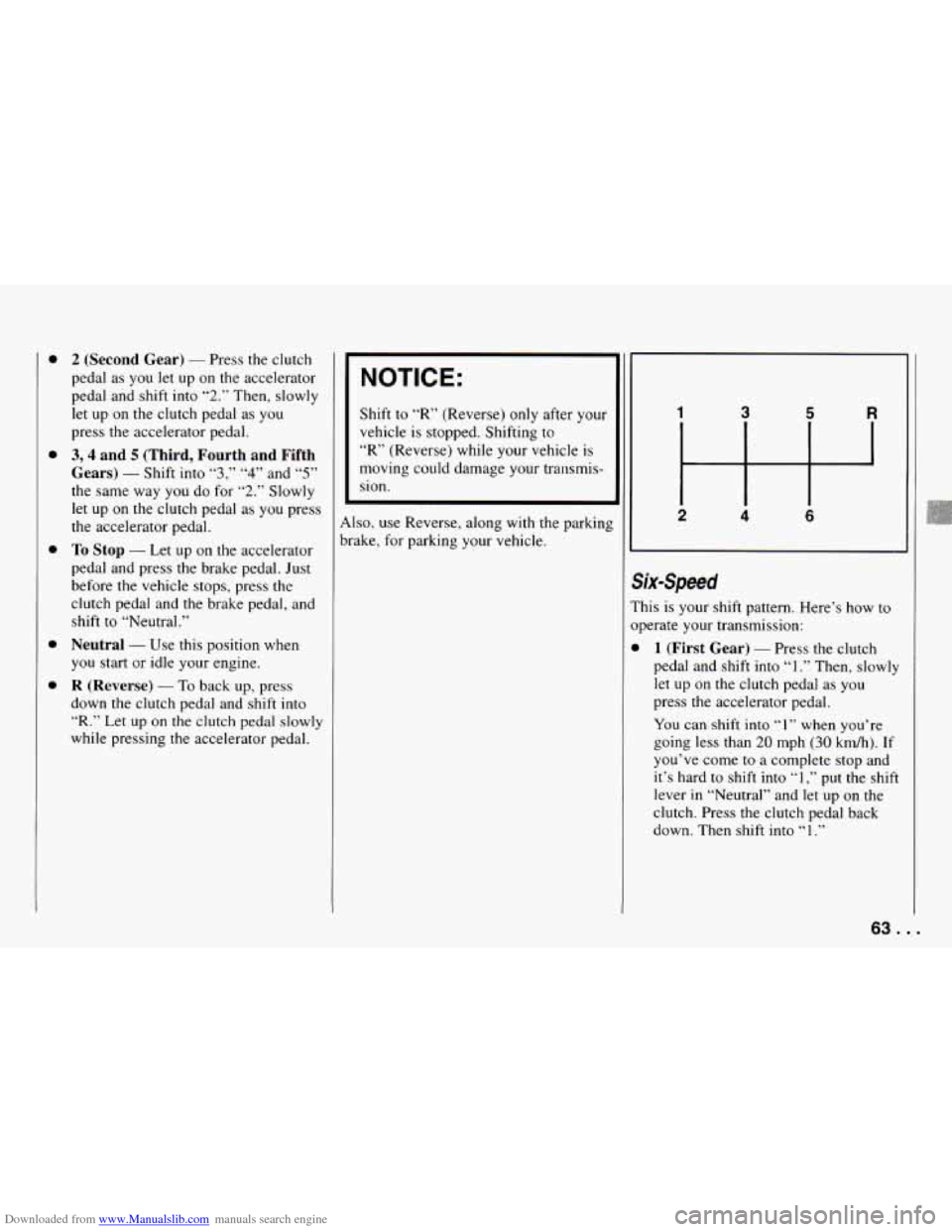
Downloaded from www.Manualslib.com manuals search engine 0
0
0
0
0
2 (Second Gear) - Press the clutch
pedal as you let up on the accelerator
pedal and shift into
“2.” Then, slowly
let up on the clutch pedal as you
press the accelerator pedal.
3,4 and 5 (Third, Fourth and Fifth
Gears)
- Shift into “3,” “4” and “5”
the same way you do for “2.” Slowly
let up on the clutch pedal as you press
the accelerator pedal.
To Stop - Let up on the accelerator
pedal and press the brake pedal. Just
before the vehicle stops, press the
clutch pedal and the brake pedal, and
shift to “Neutral.”
Neutral - Use this position when
you start or idle your engine.
R (Reverse) - To back up, press
down the clutch pedal and shift into
“R.” Let up on the clutch pedal slowly
while pressing the accelerator pedal.
NOTICE:
Shift to “R” (Reverse) only after your
vehicle is stopped. Shifting to
“R” (Reverse) while your vehicle is
moving could damage your transmis-
sion.
Also, use Reverse, along with the parking
brake, for parking your vehicle.
1 3 5 R
2 4 6
Six-Speed
This is your shift pattern. Here’s how to
operate your transmission:
0 1 (First Gear) - Press the clutch
pedal and shift into
“1.” Then, slowly
let up on the clutch pedal as
you
press the accelerator pedal.
You can shift into “1” when you’re
going less than
20 mph (30 km/h). If
you’ve come to a complete stop and
it’s hard to shift into
“1 ,” put the shift
lever in “Neutral” and let
up on the
clutch. Press the clutch pedal back
down. Then shift into
“ 1 .”
63 ...
Page 66 of 292
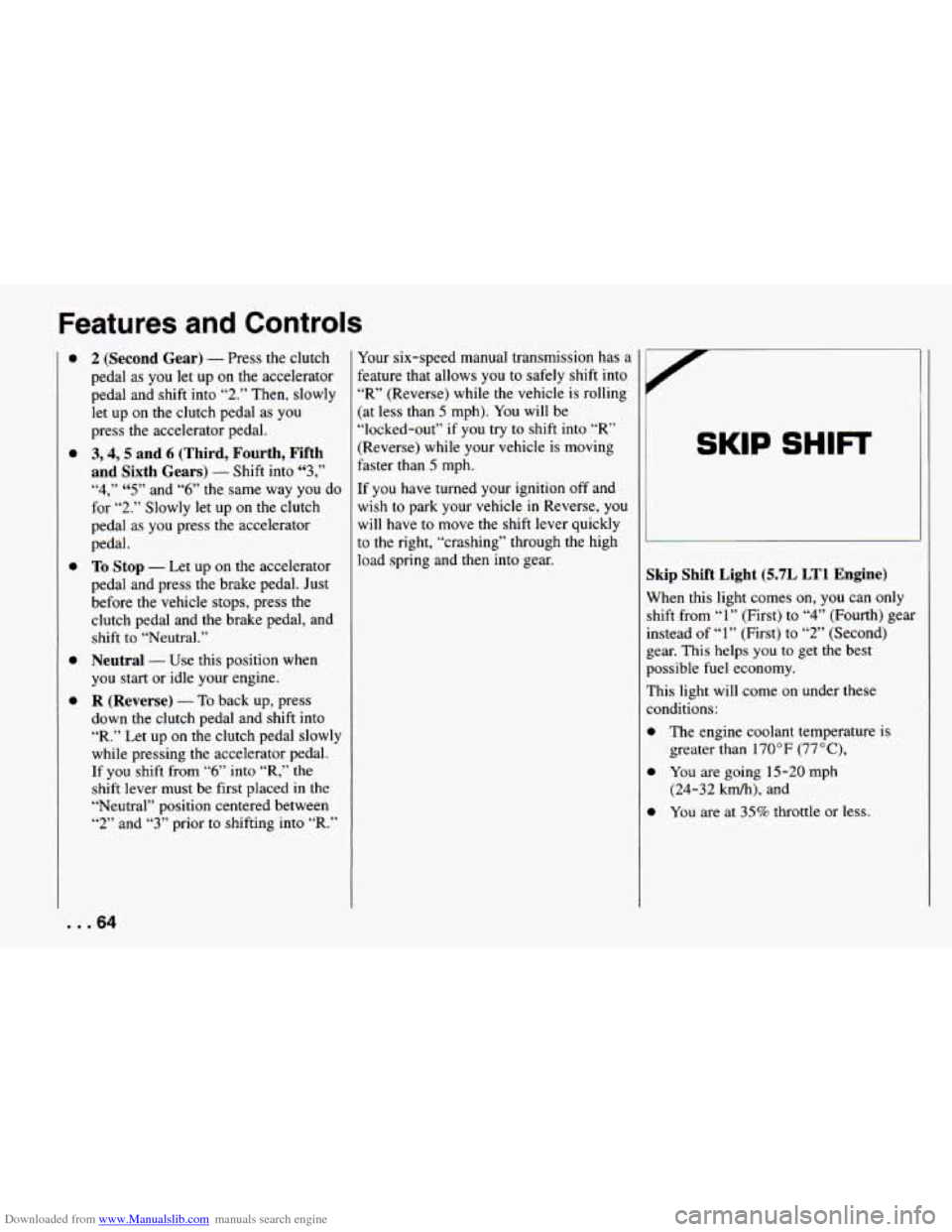
Downloaded from www.Manualslib.com manuals search engine Features and Controls
a
a
0
0
0
2 (Second Gear) - Press the clutch
pedal as you let up on the accelerator
pedal and shift into
“2.” Then, slowly
let up on the clutch pedal as you
press the accelerator pedal.
3,4,5 and 6 (Third, Fourth, Fifth
and Sixth Gears)
- Shift into “3,”
“4,” “5” and “6” the same way you do
for
“2.” Slowly let up on the clutch
pedal
as you press the accelerator
pedal.
To Stop - Let up on the accelerator
pedal and press the brake pedal. Just
before the vehicle stops, press
the
clutch pedal and the brake pedal, and
shift to “Neutral.”
Neutral - Use this position when
you start or idle your engine.
R (Reverse) - To back up, press
down the clutch pedal and shift into
“R.” Let
up on the clutch pedal slowly
while pressing the accelerator pedal.
If you shift from
“6” into “R,” the
shift lever must be first placed in the
“Neutral” position centered between
“2” and “3” prior to shifting into “R.”
Your six-speed manual transmission has a
feature that allows you to safely shift into
“R’ (Reverse) while the vehicle is rolling
(at less than
5 mph). You will be
“locked-out”
if you try to shift into “R’
(Reverse) while your vehicle is moving
faster than
5 mph.
If
you have turned your ignition off and
wish to park your vehicle
in Reverse, you
will have to move the shift lever quickly
to the right, “crashing” through the high
load spring and then into gear.
SKIP SHIFT
Skip Shift Light (5.7L LT1 Engine)
When this light comes on, you can only
shift from “1” (First) to
“4” (Fourth) gear
instead of
“1” (First) to “2” (Second)
gear. This helps you
to get the best
possible fuel economy.
This light will come on under these
conditions:
0 The engine coolant temperature is
0 You are going 15-20 mph
0 You are at 35% throttle or less.
greater than
170°F
(77”C),
(24-32 km/h), and
... 64
Page 67 of 292
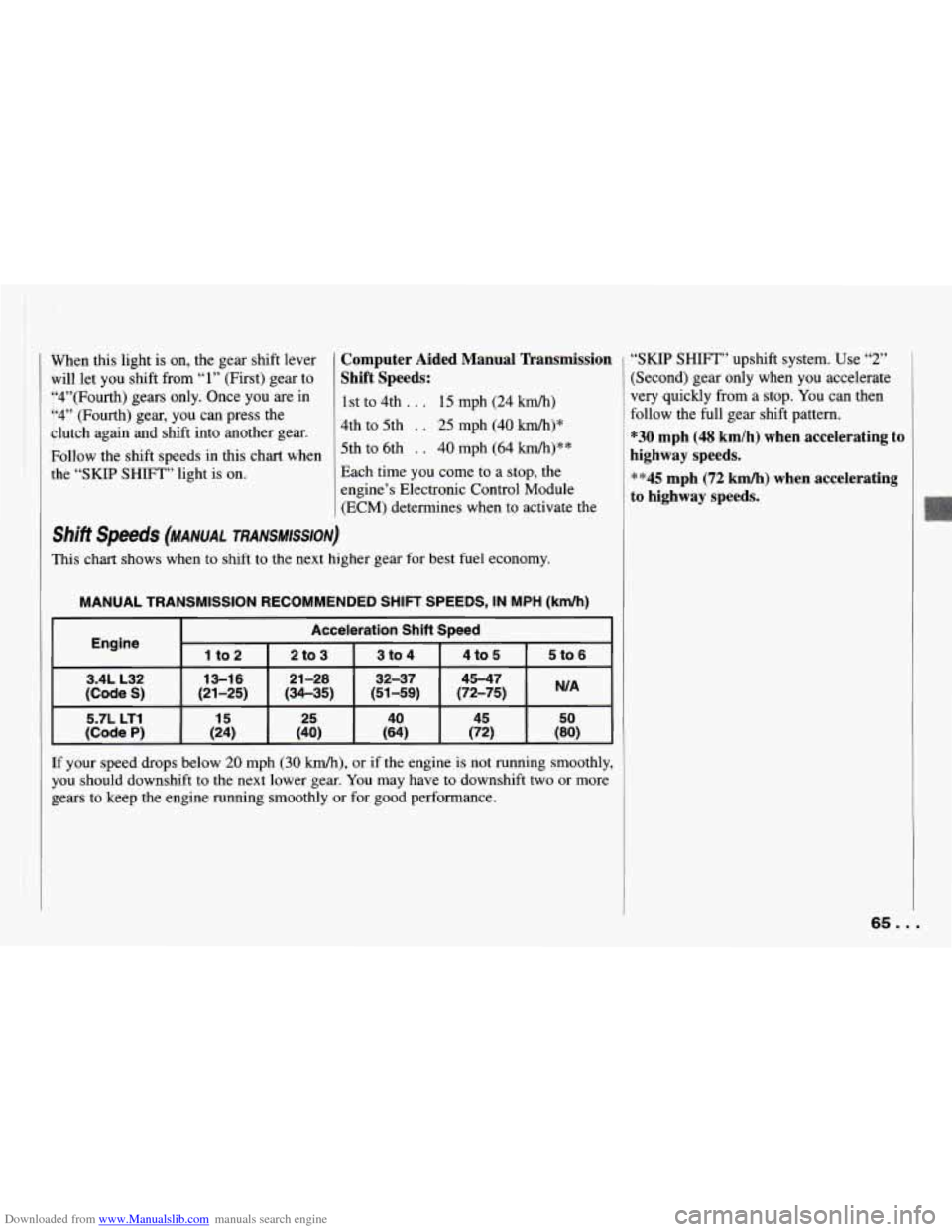
Downloaded from www.Manualslib.com manuals search engine When this light is on, the gear shift lever
will let you shift from
“1” (First) gear to
“4”(Fourth) gears only. Once you are in
“4” (Fourth) gear, you can press the
clutch again and shift into another gear.
Follow the shift speeds in this chart when
the
“SKIP SHIFT” light is on.
Computer Aided Manual Transmission
Shift Speeds:
1st to 4th . . . 15 mph (24 km/h)
4th to 5th . . 25 mph (40 km/h)*
5th to 6th . . 40 mph (64 km/h)**
Each time you come to a stop, the
engine’s Electronic Control Module
(ECM) determines when to activate the
shift speeds (MANUAL TRANSMISSION)
This chart shows when to shift to the next higher gear for best fuel economy.
MANUAL TRANSMISSION RECOMMENDED SHIFT SPEEDS, IN MPH (km/h)
Acceleration Shift Speed
Engine
1 to 2 I 2to3 I 3to4 I 4t05 I 5to6
5.7L LT1
15 25 40 45 50
(Code P) (24) (40) (64)
(72) (80)
If your speed drops below 20 mph (30 km/h), or if the engine is not running smoothly,
you should downshift to the next lower gear.
You may have to downshift two or more
gears
to keep the engine running smoothly or for good performance.
“SKIP SHIFT” upshift system. Use “2”
(Second) gear only when you accelerate
very quickly from a stop.
You can then
follow the full gear shift pattern.
“30 mph (48 km/h) when accelerating to
highway speeds.
““45 mph (72 km/h) when accelerating
to highway speeds.
65 ...
Page 68 of 292
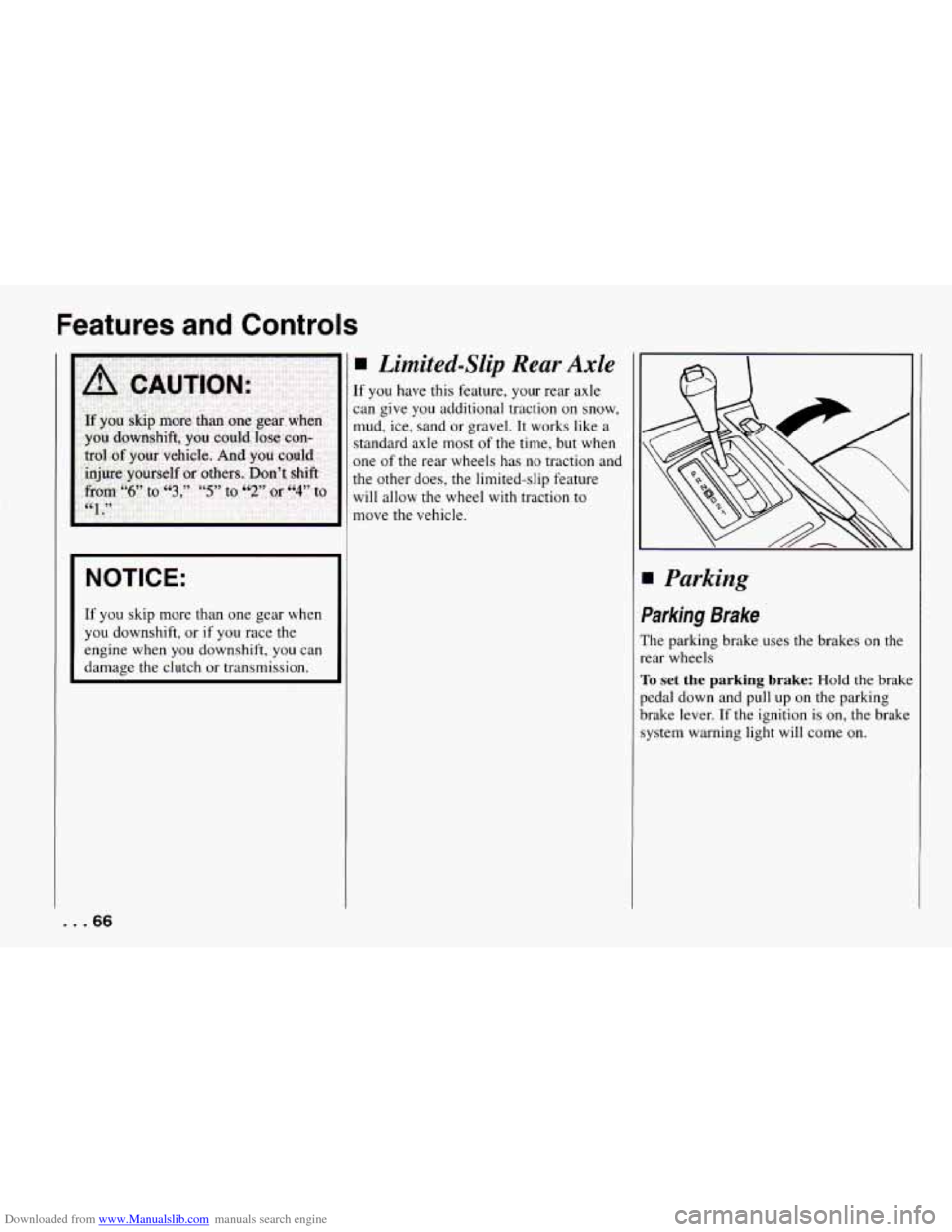
Downloaded from www.Manualslib.com manuals search engine Features and Controls
I NOTICE:
I
If you skip more than one gear when
you downshift, or if you race the
engine when
you downshift, you can
damage the clutch or transmission.
Limited-Slip Rear Axle
[f you have this feature, your rear axle
:an give you additional traction on snow,
mud, ice, sand or gravel.
It works like a
standard axle most of the time, but when
me of the rear wheels has
no traction and
:he other does, the limited-slip feature
will allow the wheel with traction to
move the vehicle.
Parking
Parking Brake
The parking brake uses the brakes on the
rear wheels
To set the parking brake: Hold the brake
pedal down and pull up on the parking
brake lever.
If the ignition is on, the brake
system warning light will come on.
... 66
Page 69 of 292
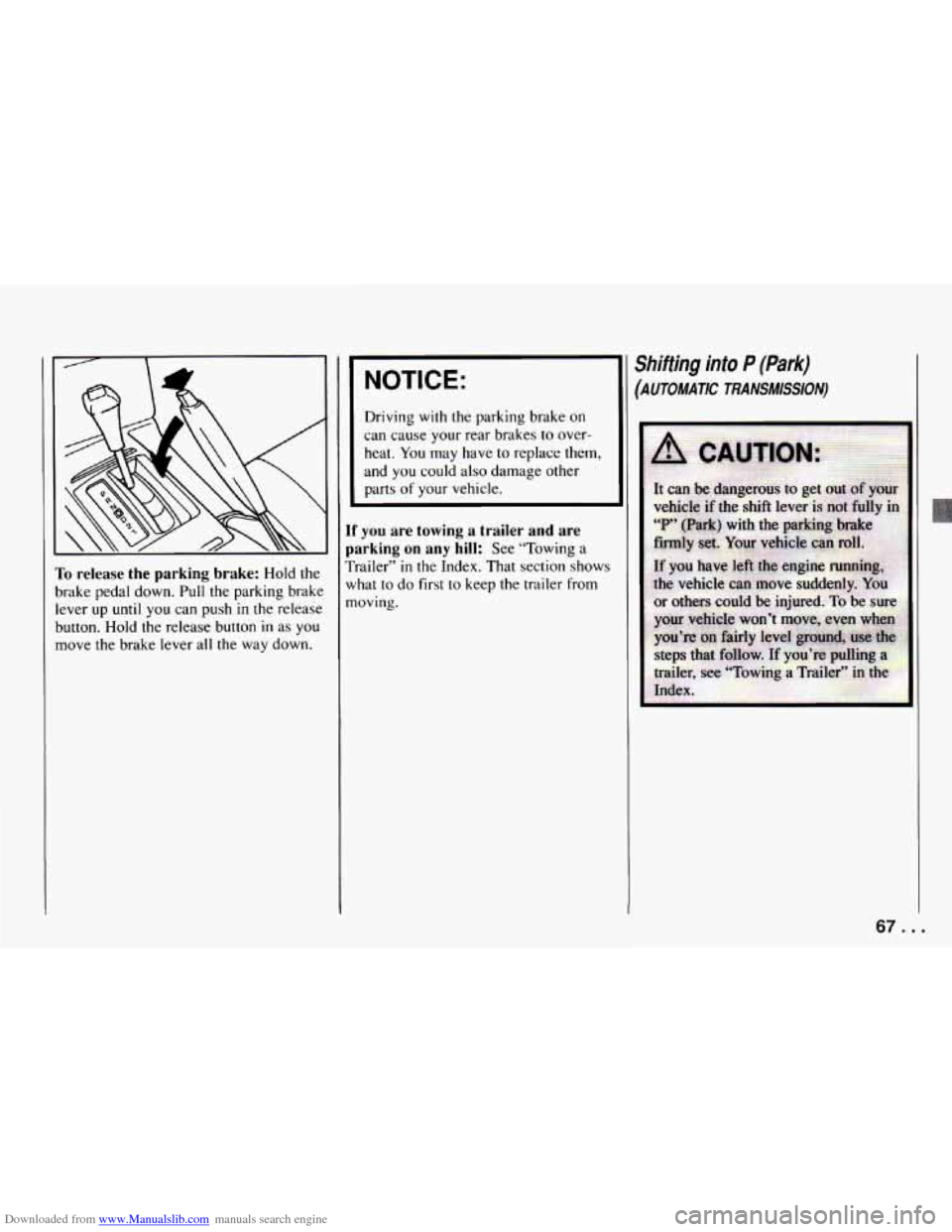
Downloaded from www.Manualslib.com manuals search engine ~ ~ ~~~ ib release the parking brake: Hold the
rake pedal down.
Pull the parking brake
zver
up until you can push in the release
wtton.
Hold the release button in as you
nove the brake lever all
the way down.
NOTICE:
Driving with the parking brake on
can cause your rear brakes to over-
heat.
You may have to replace them,
and you could also damage other
parts of your vehicle.
If you are towing a trailer and are
parking on any hill:
See “Towing a
Trailer”
in the Index. That section shows
what
to do first to keep the trailer from
moving.
Shifting into P (Park)
(AUTOMATIC TRANSMISSION)
67. .
Page 70 of 292
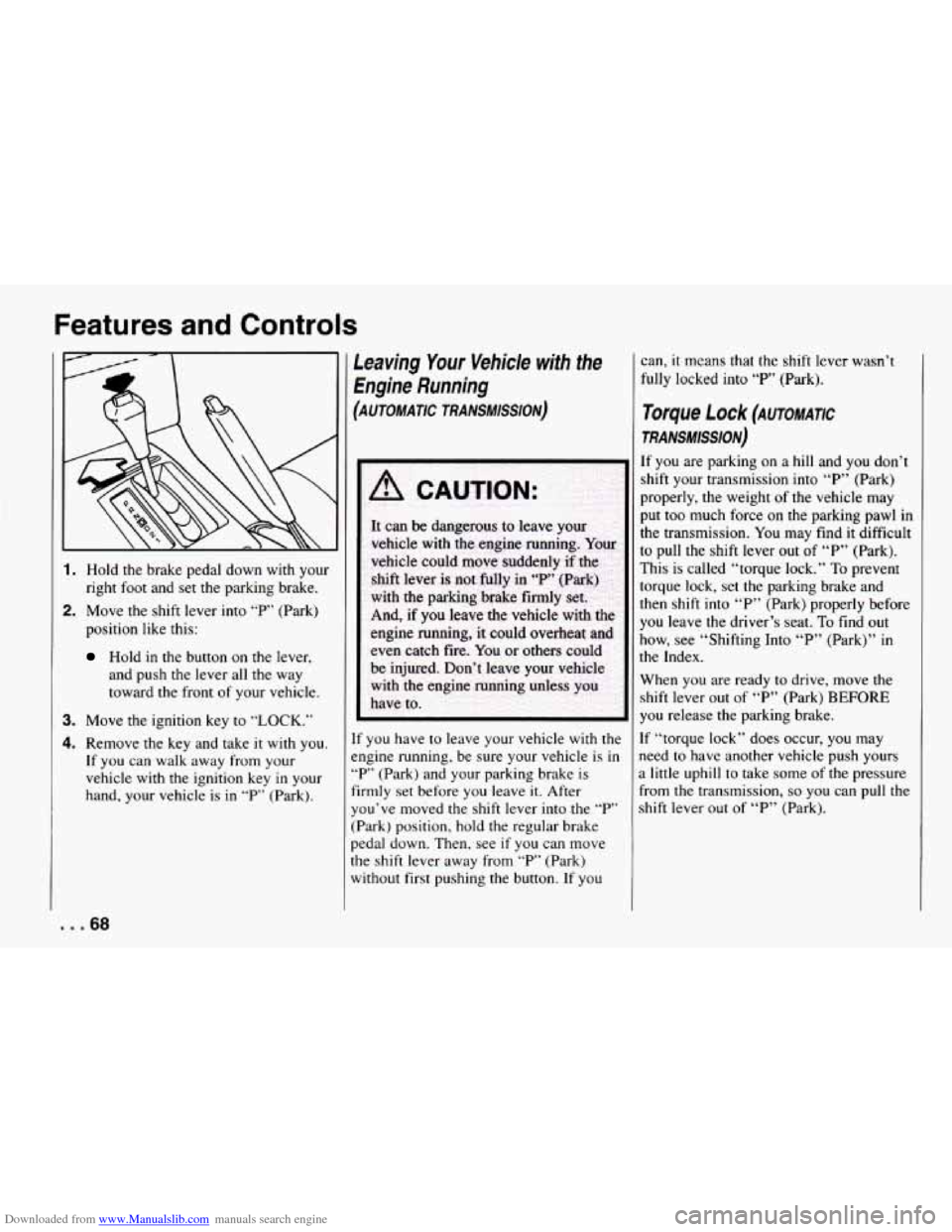
Downloaded from www.Manualslib.com manuals search engine Features and Controls
1. Hold the brake pedal down with your
right foot and set the parking brake.
2. Move the shift lever into “P’ (Park)
position like this:
Hold in the button on the lever,
and push the lever all the
way
toward the front of your vehicle.
3. Move the ignition key to “LOCK.”
4. Remove the key and take it with you.
If you can walk away from your
vehicle with
the ignition key in your
hand, your vehicle is in “P” (Park).
Leaving Your Vehicle with the
Engine Running
(AUTOMATIC TRANSMISSION)
If you have to leave your vehicle with the
engine running, be sure your vehicle is
in
“P’ (Park) and your parking brake is
firmly set before you leave it. After
you’ve moved the shift lever into the
“P’
(Park) position, hold the regular brake
pedal down. Then, see
if you can move
the shift lever away from “P” (Park)
without first pushing the button. If you can,
it means
that the shift lever wasn’t
fully locked into “P’ (Park).
Torque f Ock (AUTOMATIC
TRANS#lSSlON)
If you are parking on a hill and you don’t
shift your transmission into “P” (Park)
properly, the weight of the vehicle may
put too much force on the parking pawl in
the transmission.
You may find it difficult
to pull the shift lever out of “P” (Park).
This is called “torque lock.”
To prevent
torque lock, set
the parking brake and
then shift into “P” (Park) properly before
you leave the driver’s seat. To find out
how, see “Shifting Into “P” (Park)” in
the Index.
When you are ready to drive, move the
shift lever out of “P” (Park)
BEFORE
you release the parking brake.
If “torque lock” does occur, you may
need to have another vehicle push yours
a little uphill to take some of the pressure
From the transmission,
so you can pull the
shift lever out of “P” (Park).
... 68